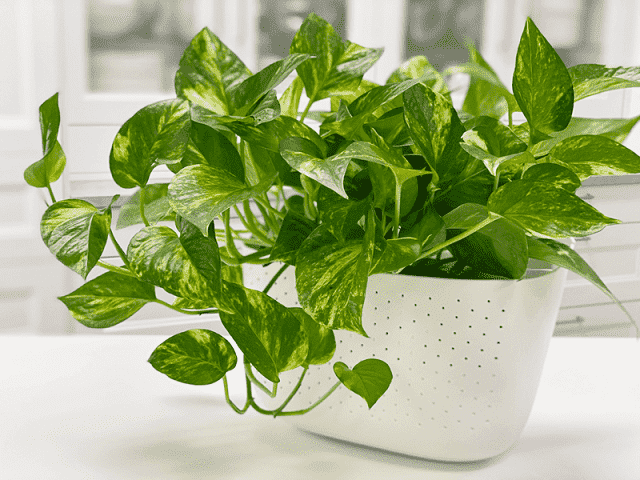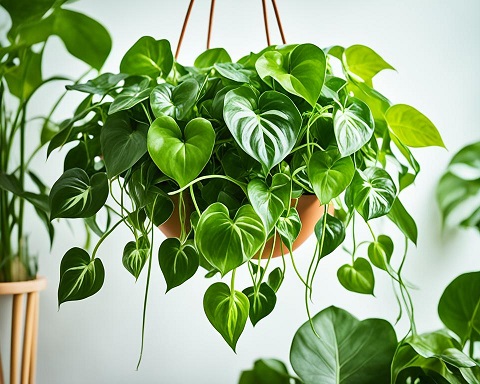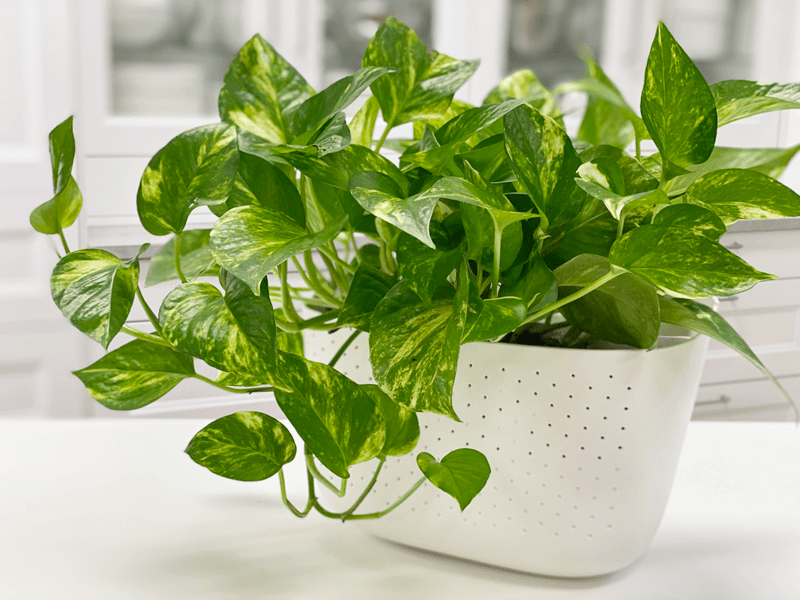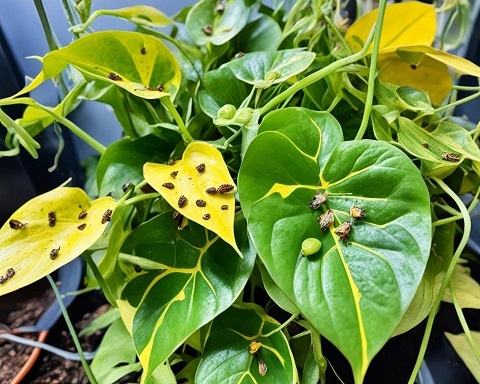
Nurturing Your Pothos: Effortless Tips for Thriving Indoor Greenery
Do you love the idea of adding a touch of natural greenery to your home, but find yourself intimidated by the thought of high-maintenance plants? If so, the pothos plant might just be the perfect solution. As a seasoned plant enthusiast, I'm excited to share my expert tips and techniques on how to properly care for a pothos, also known as devil's ivy, in this comprehensive guide.
Pothos are popular and easy-to-grow houseplants known for their trailing vines and lush, heart-shaped leaves. Whether you're a seasoned plant parent or a beginner, you'll learn everything you need to know about watering, lighting, soil, pruning, and troubleshooting common pothos plant problems. By the end, you'll be equipped with the knowledge to help your pothos thrive indoors. Let's dive in!

Why do some people struggle to keep their pothos plants healthy and thriving?
While pothos are often touted as one of the easiest houseplants to care for, even the most experienced plant enthusiasts can sometimes encounter challenges when it comes to maintaining a lush, vibrant pothos. From watering woes to lighting issues, there are a few common missteps that can lead to an unhappy, underperforming pothos. But fear not – with the right pothos plant care strategies, you can ensure your pothos plant not only survives, but truly thrives in your indoor environment.
Key Takeaways:
- Pothos plants are known for their trailing vines and lush, heart-shaped leaves.
- Proper watering, lighting, and soil conditions are essential for keeping pothos plants healthy.
- Pruning and propagation can help maintain the plant's shape and encourage new growth.
- Understanding and addressing common pothos plant problems, such as pests or nutrient deficiencies, can help your plant thrive.
- Exploring the wide variety of pothos cultivars can add visual interest to your indoor garden.
Introduction to the Pothos Plant
Pothos plants, also known as devil's ivy, are a beloved and easy-to-care-for type of houseplant. They are known for their trailing vines and glossy, heart-shaped leaves that can grow quite long. Pothos plants are a great choice for indoor cultivation as they are low-maintenance, adapt well to a variety of light conditions, and can help purify the air by removing harmful toxins.
In addition, pothos are versatile plants that can be grown in hanging baskets, placed on shelves, or trained to climb up trellises or other structures, making them a popular decorative element in homes and offices.
What is a Pothos Plant?

Pothos plants, also known as devil's ivy, are a type of trailing houseplant known for their lush, heart-shaped leaves and easy-to-care-for nature. These plants are native to the Solomon Islands and are part of the Araceae family, which includes other popular indoor plants like philodendrons and monsteras.
Benefits of Growing Pothos Indoors
Growing pothos plants indoors offers a variety of benefits. They are low-maintenance, adapting well to a range of light conditions and only requiring occasional watering. Pothos are also known for their air-purifying properties, helping to remove harmful toxins like formaldehyde and benzene from the indoor environment. Additionally, their trailing vines and vibrant foliage make them a popular choice for decorating homes and offices, adding a touch of natural greenery to any space.
How to Care for a Pothos Plant?
Caring for a pothos plant is relatively straightforward, which is why they are such a popular choice for both new and experienced plant owners. In the following sections, I'll cover the essential elements of how to care for pothos plant, including watering, lighting, soil requirements, pruning, and troubleshooting common issues. By following these guidelines, you'll be well on your way to keeping your pothos plant healthy and thriving.
Whether you're a seasoned plant parent or a beginner, understanding the pothos plant care guide is key to ensuring your indoor pothos plants reach their full potential. From proper watering techniques to choosing the right soil, this comprehensive overview will equip you with the knowledge to create the ideal growing conditions for your beloved pothos.
Pothos Watering Requirements
Proper watering is one of the most important aspects of caring for a pothos plant. Pothos are fairly drought-tolerant, but they can suffer from both overwatering and underwatering. To maintain your pothos plant's health, it's crucial to strike the right balance.
Signs of Overwatering and Underwatering
Signs of overwatering include yellowing or wilting leaves, soft or mushy stems, and root rot. Underwatered pothos will have leaves that are dry, crispy, or curling at the edges. Keeping an eye out for these visual cues can help you identify and address any issues with your pothos plant's water needs.
Ideal Watering Schedule

To keep your pothos plant thriving, aim to keep the soil moist but not saturated. I recommend watering your pothos when the top inch or two of soil becomes dry to the touch, which is typically every 7-10 days. However, you may need to adjust your watering schedule based on the plant's growth and environmental conditions, such as temperature, humidity, and light levels. By paying attention to your pothos and its soil moisture, you can ensure it receives the right amount of hydration.
Light Needs for Pothos Plants
Pothos plants are quite versatile when it comes to their light requirements.
Pothos light requirements
They thrive in a wide range of light conditions, from bright, indirect sunlight to low-light environments. The ideal lighting for pothos is an area that receives bright, indirect light for most of the day. This could be near a south- or west-facing window, or a few feet away from an east-facing window.
Ideal Light Conditions
If your pothos is exposed to too much direct sunlight, the leaves may start to yellow or become scorched. Conversely, if the plant is in very low light conditions, the leaves may become smaller and the growth may become leggy. The ideal light levels for growing pothos in your home or office is a spot that provides bright, indirect light throughout the day.
Adjusting to Low Light Levels
If you need to adjust your pothos to a new low light environment, do so gradually to allow the plant to adapt. This will help prevent stress and ensure your pothos continues to thrive, even in shaded areas. By paying attention to your plant's lighting needs and making adjustments as necessary, you can keep your pothos looking its best.
Soil and Fertilizer Requirements
Pothos plants prefer a well-draining, nutrient-rich potting mix. A general-purpose potting soil or a mix specifically formulated for indoor plants is a great choice. You can also create your own custom blend by combining equal parts of potting soil, perlite or vermiculite, and compost or peat moss. This will help ensure proper drainage and aeration for the roots.
Best Potting Mix for Pothos
When it comes to the best soil for pothos, the key is to choose a potting mix that is lightweight and well-draining. This will help prevent issues like root rot and ensure your pothos plant's roots can thrive. A general-purpose indoor potting mix or a specialized blend for indoor plants will work perfectly.
Fertilizing Schedule
As for fertilizing pothos, these plants are considered light feeders and only need to be fertilized every 2-3 months during the growing season (spring and summer). Use a balanced, water-soluble fertilizer diluted to half strength to avoid over-fertilizing, which can lead to issues like leaf burn or stunted growth.
Pruning and Propagating Pothos
Maintaining the shape and encouraging bushier growth of your pothos plant is essential, and this can be achieved through regular pruning. The best time to prune your pothos is during the spring or early summer when the plant is actively growing. Use clean, sharp scissors or pruning shears to snip off any damaged, dead, or overly long stems. This not only keeps your pothos looking tidy but also helps prevent the plant from becoming leggy.
When and How to Prune Pothos
The optimal time to prune your pothos is in the spring or early summer when the plant is actively growing. This is the best time to trim back any damaged, dead, or excessively long stems. Use clean, sharp scissors or pruning shears to make clean cuts just above a leaf node. This will encourage the plant to produce more foliage and maintain a full, bushy appearance.
Propagating Pothos from Cuttings
In addition to pruning, you can easily propagate pothos by taking stem cuttings. Simply cut a 4-6 inch section of stem just below a leaf node, remove the lower leaves, and place the cutting in water or a well-draining potting mix. Within a few weeks, you'll start to see new roots forming. Once the roots are established, you can then transplant the cutting into its own pot and enjoy a brand-new pothos plant.
Common Pothos Plant Problems
While pothos plants are generally low-maintenance, they can sometimes encounter issues that require attention. Identifying and addressing these problems promptly is key to keeping your pothos thriving.
Identifying and Treating Pests
Common pests that may affect pothos plants include spider mites, mealybugs, and aphids. These can be identified by the presence of tiny bugs or webbing on the leaves and stems. To treat pest infestations, you can wipe down the plant with a damp cloth, use insecticidal soap, or introduce beneficial insects like ladybugs.
Troubleshooting Common Issues
Other common pothos problems include yellowing leaves, drooping foliage, or brown, crispy leaf edges. These can be caused by factors like overwatering, underwatering, or nutrient deficiencies. Addressing these issues promptly and making adjustments to your care routine can help get your pothos plant back on track.
By staying vigilant and responding quickly to any signs of trouble, you can ensure your pothos plant remains healthy and thriving for years to come.

Pothos Plant Varieties
While the classic pothos plant with its solid green leaves is the most widely recognized variety, there are several other pothos cultivars and hybrids to explore. These different types of pothos offer a range of leaf shapes, colors, and growth patterns, allowing you to find the perfect popular pothos plants to suit your space and personal style.
Popular Cultivars and Their Characteristics
| Pothos Variety | Leaf Color | Leaf Pattern | Growth Habit |
|---|---|---|---|
| Golden Pothos | Bright, golden-yellow with green edges | Solid coloration | Trailing, vigorous growth |
| Neon Pothos | Vibrant, neon-green leaves | Solid coloration | Trailing, fast growth |
| Marble Queen Pothos | Creamy-white with green variegation | Marbled pattern | Trailing, moderate growth |
| Manjula Pothos | Creamy-white with green and yellow variegation | Mottled, wavy pattern | Trailing, compact growth |
| Jade Pothos | Solid, deep green leaves | Solid coloration | Trailing, vigorous growth |
Exploring the different pothos plant varieties can be a fun way to add visual interest and diversity to your indoor plant collection. Whether you prefer the bold colors of the Neon Pothos or the elegant, variegated leaves of the Marble Queen, there's a pothos cultivar out there to suit your style and growing conditions.
Conclusion
In conclusion, pothos plants are a fantastic choice for both new and experienced plant enthusiasts. By following the care guidelines outlined in this comprehensive guide, you'll be well on your way to growing a thriving, beautiful pothos in your home or office. Remember to keep an eye on the watering, lighting, and soil needs, and don't hesitate to prune and propagate your plant as needed. With the right care, your pothos will reward you with lush, trailing vines and glossy, heart-shaped leaves for years to come.
The key tips for growing healthy pothos include maintaining the proper watering schedule, providing the right amount of indirect sunlight, and using a well-draining, nutrient-rich potting mix. By staying vigilant and addressing any issues promptly, you can ensure your pothos plant thrives and continues to be a low-maintenance, air-purifying addition to your indoor space. Happy planting!
As a summary of pothos plant care, this guide has covered everything from watering requirements and lighting needs to pruning, propagation, and troubleshooting common problems. By implementing these strategies, you'll be able to enjoy the many benefits of this versatile and easy-to-grow houseplant for a long time to come.
FAQ
What is a Pothos Plant?
Pothos plants, also known as devil's ivy, are a beloved and easy-to-care-for type of houseplant. They are known for their trailing vines and glossy, heart-shaped leaves that can grow quite long.
What are the Benefits of Growing Pothos Indoors?
Pothos plants are a great choice for indoor cultivation as they are low-maintenance, adapt well to a variety of light conditions, and can help purify the air by removing harmful toxins. They are also versatile plants that can be grown in hanging baskets, placed on shelves, or trained to climb up trellises or other structures, making them a popular decorative element in homes and offices.
How Much Water Do Pothos Plants Need?
Proper watering is one of the most important aspects of caring for a pothos plant. Pothos are fairly drought-tolerant, but they can suffer from both overwatering and underwatering. To maintain your pothos plant's health, aim to keep the soil moist but not saturated. I recommend watering your pothos when the top inch or two of soil becomes dry to the touch, which is typically every 7-10 days. Adjust your watering schedule as needed based on the plant's growth and environmental conditions.
What Lighting Conditions Do Pothos Plants Prefer?
Pothos plants are quite versatile when it comes to their lighting needs. They thrive in a wide range of light conditions, from bright, indirect sunlight to low-light environments. The ideal placement for a pothos is in an area that receives bright, indirect light for most of the day. If your pothos is exposed to too much direct sunlight, the leaves may start to yellow or become scorched. Conversely, if the plant is in very low light conditions, the leaves may become smaller and the growth may become leggy.
What Type of Soil and Fertilizer Do Pothos Plants Need?
Pothos plants prefer a well-draining, nutrient-rich potting mix. A general-purpose potting soil or a mix specifically formulated for indoor plants is a great choice. As for fertilizing, pothos are light feeders and only need to be fertilized every 2-3 months during the growing season (spring and summer). Use a balanced, water-soluble fertilizer diluted to half strength to avoid over-fertilizing.
How Do I Prune and Propagate a Pothos Plant?
Pruning your pothos plant is essential for maintaining its shape and encouraging bushier growth. The best time to prune is in the spring or early summer when the plant is actively growing. Use clean, sharp scissors or pruning shears to snip off any damaged, dead, or overly long stems. You can also easily propagate pothos by taking stem cuttings and rooting them in water or a well-draining potting mix.
What are Some Common Pothos Plant Problems?
While pothos plants are generally low-maintenance, they can sometimes encounter issues that require attention. Common problems include pests like spider mites, mealybugs, or aphids, as well as issues like yellowing leaves, drooping foliage, or brown, crispy leaf edges, which can be caused by factors like overwatering, underwatering, or nutrient deficiencies. Addressing these issues promptly and making adjustments to your care routine can help get your pothos plant back on track.
What are the Different Varieties of Pothos Plants?
While the classic pothos plant with its solid green leaves is the most widely recognized variety, there are several other cultivars and hybrids to explore, including the Golden Pothos, Neon Pothos, Marble Queen Pothos, Pearl & Jade Pothos and more, each with their own unique leaf patterns and colors.



